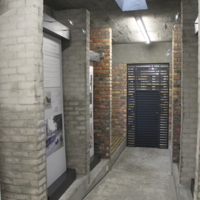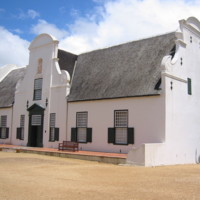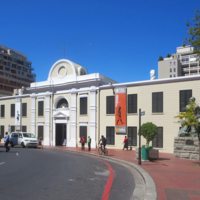
Prestwich Memorial
The Prestwich Memorial opened in 2008 as an attempt at resolving a protracted and sometimes unsavoury dispute sparked in 2003 when a property developer discovered human remains in central Cape Town whilst digging the foundations for an apartment complex. These remains were likely those of the colonial working classes, buried in the many unmarked eighteenth and nineteenth century graves. For certain activists, the remains were identified as those of their enslaved ancestors. A dispute began between people opposing exhumation on the grounds of respect for ancestors, versus those who advocated exhumation owing to the unprecedented opportunities offered to furthering historical and scientific knowledge. Following a public consultation process, the bones were exhumed, but were not subjected to analysis.
The memorial was constructed on behalf of the City of Cape Town municipality to house the remains, and provide an exhibition space to explain the affair. The opening of an artisan coffee shop named Truth in the memorial building in 2010 however created further contestations on the grounds of taste and respect for the dead.
The memorial features a number of fixed interpretation boards which explain the colonial burial system, the unmarked cemeteries beneath the modern city, and the type of people likely to have been buried in them. Enslaved people, of course, feature in this number. The bones themselves are situated in an ossuary area, accessible by a low entrance. They are separated from the public by a wooden gate. Whilst research applications to study the bones are invited, no applications have been accepted at the time of writing by a panel including stakeholders from various sides of the exhumation debate.

Groot Constantia
Founded in 1685, Groot Constantia is South Africa’s oldest wine estate. Like the majority of wine estates of a similar vintage in the Cape Town area, its labour force prior to emancipation in 1834 rested on enslavement. Following a vine disease outbreak in the late nineteenth century, the estate passed into government ownership. It is currently operated by the arms-length Groot Constantia Trust. The manor house was rebuilt in Cape Dutch style following a fire in 1925, and has operated as a preserved site since that time. The manor house passed into the control of the South African Cultural History Museum in 1969 and, as with other sites managed by the same entity, became part of southern state-funded umbrella Iziko Museums in 1998.
Iziko’s inauguration signalled a shift towards previously marginalised histories at all its sites, with Groot Constantia no different. A revised history of Groot Constantia paying greater attention to enslaved people was written by curator Thijs van der Merwe and published in 1997. Buildings which had potentially served either as stables and/or as slave quarters were repurposed as an Orientation Centre in October 2004. As the first heritage space which the visitor reaches upon arrival, displays in this building foreground the Cloete family – owners from 1779 to 1885 – as ‘farm owners and slave owners’. Drawn from archival research, their human transactions are listed, whilst the origins, names, and worked carried out by people enslaved at Groot Constantia are also listed. A panel is devoted to the ‘young servant boy’ Friday, whose ancestral origins are linked to the suppression of the slave trade by the British Royal Navy. The selection of this story can partially be attributed to the availability of suitable museological material, given that a photograph of Friday carrying Bonnie Cloete’s archery set is included.

Slave Lodge
The Slave Lodge building was first constructed in 1679 by the VOC as housing for the people they enslaved. It was modified over time, and post-British settlement of the Cape was transformed into government offices. After passing through various stages of administrative use – most notably as the Supreme Court – it opened as the South African Cultural History Museum in 1967.
Typical of apartheid-era museology, its displays made no reference to the building’s connections with slavery. Post-apartheid, the museum was brought under the management of southern state umbrella Iziko Museums, and was renamed Slave Lodge in 1998. Although a number of its displays still date from the Cultural History Museum period, new exhibitions have been installed, and the museum now purports to serve as a centre where human rights abuses are discussed and exposed. There is a particular focus on slavery, and racial segregation under apartheid, both through permanent and temporary displays.
The main slavery exhibition is titled ‘Remembering Slavery’ and opened in 2006. This occupies the western wing of the ground floor of the museum. The exhibition offers a comprehensive overview of Cape slavery, with galleries focussing on contextual history, the Slave Lodge building, the middle passage, slave trading routes in the Indian and Atlantic Oceans, and a recreation of life in the eighteenth century Slave Lodge. Owing to the paucity of material remnants of slavery at the Cape, the exhibition relies on text to a large extent. Tapping in to the ‘reconciliation’ narrative of the early Mandela years, its overall effect is to portray slavery as a South African history which the country has learned from.
The opposite wing of the building hosts a changing selection of temporary exhibitions which have focussed on human rights abuses including the anti-apartheid struggle and women’s rights. The museum offers a comprehensive education programme with a particular focus on slavery.